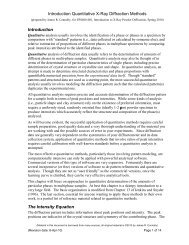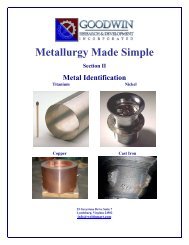Metallography and Microstructures of Cast Iron
Metallography and Microstructures of Cast Iron
Metallography and Microstructures of Cast Iron
Create successful ePaper yourself
Turn your PDF publications into a flip-book with our unique Google optimized e-Paper software.
570 / <strong>Metallography</strong> <strong>and</strong> <strong>Microstructures</strong> <strong>of</strong> Ferrous AlloysMicroexamination MethodsFig. 16 As-cast ductile iron (Fe-3.07%C-0.06%Mn-2.89%Si-0.006%P-0.015%S-0.029%Mg). C,cementite; L, ledeburite; F, ferrite; <strong>and</strong> P, pearlite. Etchedwith 4% nital. 650 (microscopic magnification 500)Chemical Etching. The examination <strong>of</strong> theiron microstructure with a light optical microscopeis always the first step for phase identification<strong>and</strong> morphology. One should always beginmicrostructural investigations by examiningthe as-polished specimen before etching. This isa necessity, <strong>of</strong> course, for cast iron specimens, ifone is to properly examine the graphite phase.Fig. 18 As-cast gray iron (Fe-3.24%C-2.32%Si-0.54%Mn-0.71%P-0.1%S). E, phosphorousternary eutectic. Etched with 4% nital. 100St<strong>and</strong>ard Etchants. To see the microstructuraldetails, specimens must be etched. Etchingmethods based on chemical corrosive processeshave been used by metallographers for manyyears to reveal structures for black-<strong>and</strong>-whiteimaging.Specimens <strong>of</strong> nonalloyed <strong>and</strong> low-alloyedirons containing ferrite, pearlite, the phosphoruseutectic (steadite), cementite, martensite, <strong>and</strong>bainite can be etched successfully with nital atroom temperature to reveal all <strong>of</strong> these microstructuralconstituents. Usually, this is a2to4%alcohol solution <strong>of</strong> nitric acid (HNO 3 ) (Table 2,etch No. 1). Figure 11 shows a nearly ferriticannealed ductile iron with uniformly etchedgrain boundaries <strong>of</strong> ferrite <strong>and</strong> a small amount<strong>of</strong> pearlite. Nital is very sensitive to the crystallographicorientation <strong>of</strong> pearlite grains, so, in thecase <strong>of</strong> a fully pearlitic structure, it is recommendedto use picral, which is an alcohol solution<strong>of</strong> 4% picric acid (Table 2, etch No. 2). Figures12 <strong>and</strong> 13 show the differences in revealingthe microstructure <strong>of</strong> pearlite with nital or picral.Picral does not etch the ferrite grain boundaries,or as-quenched martensite, but it etches the pearliticstructure more uniformly, while nital leaveswhite, unetched areas, especially in the casewhere pearlite is very fine.When the austempering heat treatment is veryshort, the microstructure <strong>of</strong> austempered ductileiron (ADI) consists <strong>of</strong> martensite <strong>and</strong> a smallamount <strong>of</strong> acicular ferrite. After etching in 4%nital, martensite as well as acicular ferrite areboth etched intensively, which makes it very dif-Fig. 17 Same as in Fig. 16 but after etching with hotalkaline sodium picrate. C, eutectic cementite;L, ledeburite; F, ferrite; <strong>and</strong> P, pearlite with slightly etchedcementite. 650 (microscopic magnification 500)Fig. 19 Same as in Fig. 18 but after etching with KlemmI reagent. E, phosphorous ternary eutectic.100Fig. 20 Austempered ductile iron (Fe-3.6%C-2.5%Si-0.06%P-1.5%Ni-0.7%Cu). CB, cell boundaries;H, ferritic halo around the graphite nodules. Etchedwith Klemm I reagent. 200








